Create this leaf-shaped birdbath in a few hours with common tools and materials.
Multiple weeks
Beginner
less than $30
Introduction
Here's how to make a simple, non-toxic birdbath. All it takes is a few hours of work and some curing time.
Birdbaths add an artistic flare to any garden while attracting local and migrating birds.
Birdbaths can be on pedestals or closer to the ground. Pedestals are more visible and offer a quick dip, whereas baths nestled into the garden act more like a natural water source. The latter type attracts birds that like to stay low yet love a safe spot from predators.
This simple leaf-shaped birdbath is easy to make. It can be placed on a tomato cage or pedestal for increased visibility, or draped on a flower bed to mimic a more natural setting. Either way, with some thought and care, this birdbath should delight your feathered friends.
Tools Required
- Large sheet of plastic (upcycle an old shower curtain)
- Mixing tray for concrete
- Paint brush
- Rag or foam brush
- Scissors
- Trowel
Materials Required
- 1 Medium to large leaf
- 10-lb bag of Quikrete Vinyl Concrete Patcher
- 50-lb bag of sand
- Chicken wire
- Disposable gloves
- Non-toxic paint or concrete dye
- Non-toxic sealant like Tung oil
- Vegetable oil
- Water
Watch How To Make a Birdbath
Project step-by-step (10)
Build a sand dome
Put down plastic and pour sand on top. Make a domed pile of sand so the leaf holds its shape. If needed, add a little water as well.
NOTE: Birds don’t like baths more than a couple of inches deep, so keep this dome shallow.
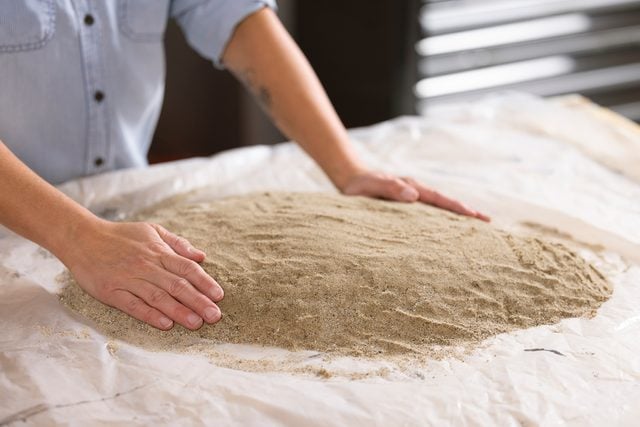
Prep the leaf
Use a large leaf for a decently sized birdbath. I recommend a rhubarb or burdock leaf. If those aren’t available, try an elephant ear or similar houseplant.
Place the leaf on the sand dome and cut the stem at the base of the leaf. Then rub vegetable oil on the veiny side of the leaf. This will help it come off the hardened concrete smoothly.
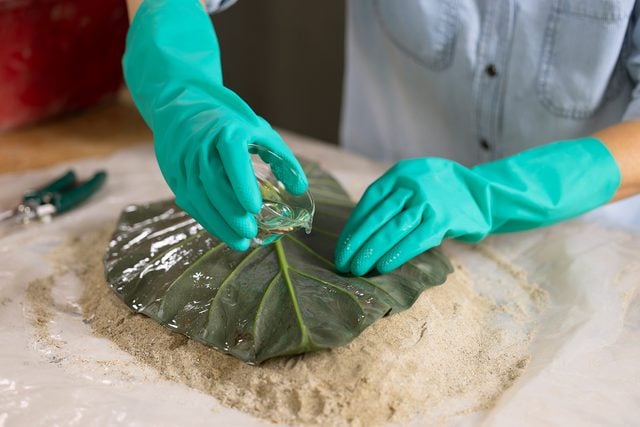
Mix concrete
You can use various types of concrete and cement mixes. I originally tried some quick dry cement I had left over from building a deck, but the small rocks it contained gave it more texture than I wanted.
Luckily, I also had some vinyl concrete patcher left over from a driveway project. This comes as a fine powder, leaving a nice, smooth finish that really captures the details in the leaf.
Pour the concrete in a mixing tray and slowly add water until it’s the consistency of brownie mix.
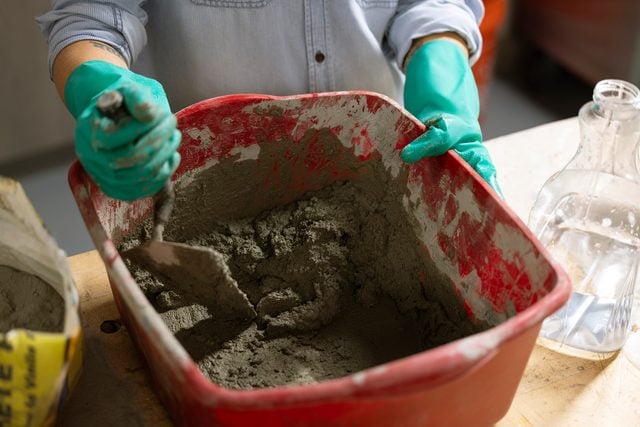
Cover the leaf with concrete
Scoop concrete onto the leaf until it’s covered. The center of the leaf should be thicker (around 3/4-inch) than the edges (about 1/4-inch).
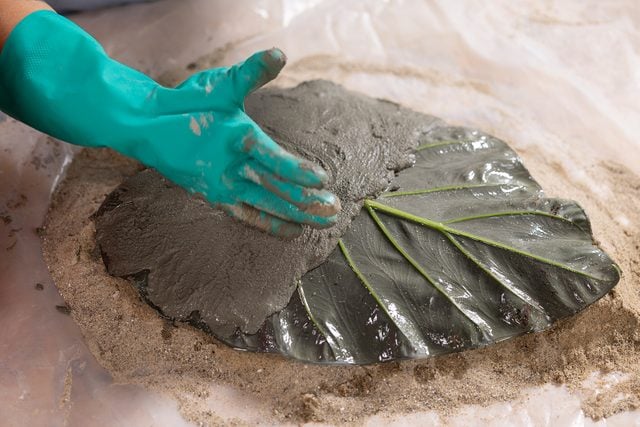
Add chicken wire
Add chicken wire between layers of concrete for added stability. I like to cut the wire in the shape of the leaf.
Once the chicken wire is in place, layer an additional 1/8-in. to 1/4-in. coat of concrete on top of it so it’s buried.

Create an flat base
You can create an extended flat base on the center of the birdbath. This will act as a slight pedestal to keep the bath basin in place.
Whether you leave it as-is or add a flat base, allow it to dry for about 48 hours. If need be, cover it with plastic to protect it while it dries.
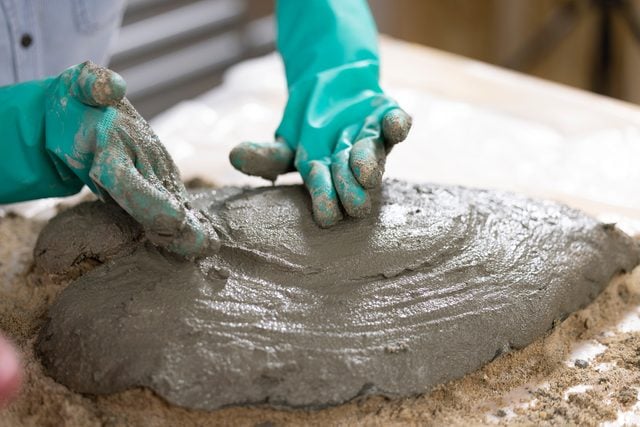
Remove the leaf
Take it off the sand, turn it over, then pull off the leaf. Let this cure for a week before painting or adding a sealant. Avoid direct sunlight.
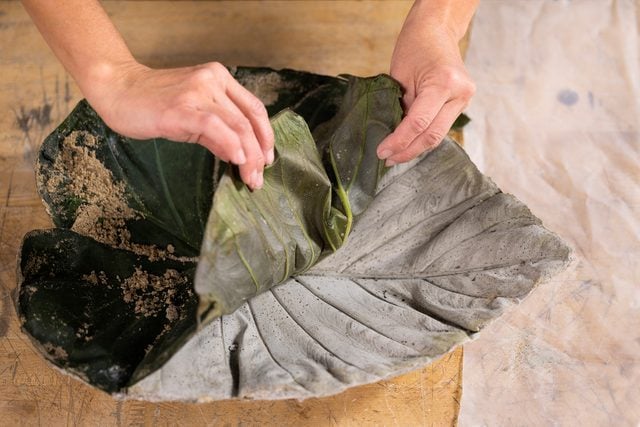
Paint the birdbath
Paint the birdbath with a thin wash of non-toxic paint. I used milk paint since it’s made from natural ingredients like milk protein, clay and natural pigments. You could also use bilge paint designed for water basins.
Also consider color choices. Neutral colors like greens and browns create a safe bath that’s camouflaged, whereas brighter colors like blues, reds, and yellows draws a bird’s attention.
Start with a thin wash of paint so the intricate details of the leaf pattern show. Continue to add coats until you reach your desired hue. The paint dries quickly so you won’t have to wait long to add additional coats.
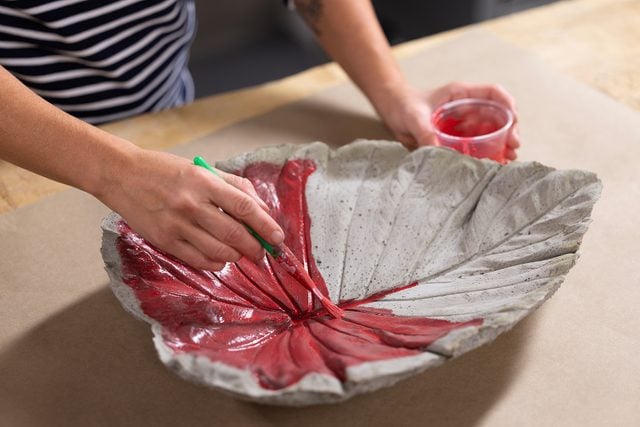
Seal concrete birdbath
Use a non-toxic sealant that’s safe for birds. Tung oil is a sustainable sealant that absorbs into porous materials.
To use, pour a small amount directly onto the birdbath and rub it in with a rag or foam brush. Be sure to cover every nook and cranny. Wait about 30 to 60 minutes for it to dry, and then add another coat. Two to five coats should do it.
Wait 30 days before adding water to the birdbath. This allows to the sealant to cure, the best way to ensure your creation lasts a long time.

FAQs
How do I attract birds to my birdbath?
Location is the most important factor. If possible, place it in a shady or semi-shady area near trees or bushes for perching or a quick escape. Make sure the water is clean and shallow, approximately one to two inches deep. Placing a bird feeder nearby encourages birds to visit.
How do I clean a birdbath?
Follow these steps to clean a birdbath:
- After emptying the old water, use a garden hose sprayer to remove dirt and grime.
- Scrub it out with a soft bristled brush and a mixture of nine parts warm water and one part vinegar.
- Thoroughly rinse with a garden hose.
- Refill with fresh, cool water.
How do I keep mosquitos from breeding in my birdbath?
By changing the water regularly — at least once a week, more often if you can. A single mosquito can lay as many as 200 eggs, generating flying, blood-sucking pests in as little as eight days.




















